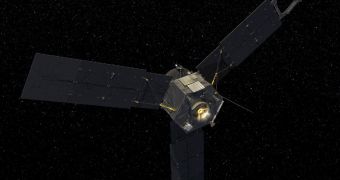Officials at the NASA Jet Propulsion Laboratory (JPL) in Pasadena, California, announce that the Juno spacecraft has recently completed its second course-correction maneuver. The probe is currently flying on its established path, heading for Jupiter.
The second Deep Space Maneuver (DSM-2) was carried out on Friday, September 14, and involved firing the vehicle's main engines for around 30 minutes. The goal was to further refine Juno's trajectory after DSM-1, setting it on a course that will take the spacecraft around Earth next year.
JPL experts say that the maneuver started at 6:30 pm EDT (2230 GMT), with the firing of the Leros-1b main thruster. By 7 pm EDT, the required burn had been completed, and the engine shut down.
Telemetry data from the spacecraft indicated that its velocity was changed by 867 miles per hour (388 meters per second), and that it consumed around 829 pounds (376 kilograms) of fuel while doing so. At this point, the probe is 298 million miles (480 million kilometers) away from Earth.
The flyby is scheduled to occur on October 9, 2013, when Juno will pass within a few hundred miles of the planet. This will change its direction and velocity enough to make it reach Jupiter in August 2016.
At the point of closest approach, the probe will pass within 348 miles (560 kilometers) of Earth's surface. The flyby will change Juno's velocity by 16,330 miles per hour (~ 7.3 kilometers per second).
“It feels like we hit back-to-back home runs here with the near-flawless propulsion system performance seen during both DSM-1 and DSM-2,” says JPL expert Rick Nybakken, who manages the Juno project.
“These successes move us closer to being ready for our most critical mission event, the Jupiter Orbit Insertion main engine burn in July 2016. We're not in the playoffs yet, as that will come in 2016 when we arrive at Jupiter, but it does feel fantastic to have hit both of these DSMs out of the park,” he says.
Juno took off aboard an Atlas V delivery system on August 5, 2011, from Space Launch Complex 41 (SLC-41) at the Cape Canaveral Air Force Station (CCAFS), in Florida. Though headed for Jupiter, the probe is powered by solar panels.
Once it arrives at the solar system's largest planet, the spacecraft will perform 33 orbits around its poles. During this time, it will use a suite of eight scientific instruments to collect data on the Jovian atmosphere, focusing on its structure, the nature of its magnetosphere, and so on.
NASA experts hope that this mission will enable a clearer understanding of how the planet itself formed, whether or not it has a solid core, and what its overall properties are.

 14 DAY TRIAL //
14 DAY TRIAL //